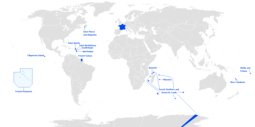French Somaliland
French Somaliland Côte française des Somalis Dhulka Soomaaliyeed ee Faransiiska الساحل الصومالي الفرنسي وتوابعه | |||||||||
|---|---|---|---|---|---|---|---|---|---|
| 1883–1967 | |||||||||
 | |||||||||
| Anthem: La Marseillaise | |||||||||
 French Somaliland in 1922 | |||||||||
| Status | Colony of France (1884–1946) Overseas territory of France (1946–1967) | ||||||||
| Capital | Djibouti | ||||||||
| Common languages | French, Somali, Afar, Arabic | ||||||||
| Religion | Christianity, Islam | ||||||||
| Demonym(s) | Somali French Somali | ||||||||
| Government | Dependent territory | ||||||||
| Governor | |||||||||
• 1884–1899 | Léonce Lagarde | ||||||||
• 1966–1967 | Louis Saget | ||||||||
| Historical era | New Imperialism | ||||||||
• Established | May 20 1883 | ||||||||
| June 18, 1940 | |||||||||
| December 28, 1942 | |||||||||
• Status changed to overseas territory | October 27, 1946 | ||||||||
• Renamed | July 5 1967 | ||||||||
| Area | |||||||||
| 1960 | 23,200 km2 (9,000 sq mi) | ||||||||
| Population | |||||||||
• 1960 | 83,636 | ||||||||
| Currency | French franc (1883–1949) (1949–1967) | ||||||||
| |||||||||
| Today part of | Djibouti | ||||||||
| History of Djibouti |
|---|
 |
| Prehistory |
| Antiquity |
|
| Middle Ages |
|
| Colonial period |
|
| Modern period |
| Republic of Djibouti |
|
|
French Somaliland (French: Côte française des Somalis, lit. "French Coast of the Somalis" Somali: Dhulka Soomaaliyeed ee Faransiiska) was a French colony in the Horn of Africa. It existed between 1884 and 1967. Djibouti is its legal successor state.[1]
History[]
French Somaliland was established in 1896 after the Issa[2] and Afar each signed a treaty with the French. The March 11, 1862 treaty signed by Afar Sultan Raieta Dini Ahmet in Paris ceded the territory of Obock for 10,000 thalaris, around 55,000 francs. Later on, that treaty was used by Captain Alphonse Fleuriot de Langle to colonize the south of the Bay of Tadjoura. On March 26, 1885 the French signed another treaty with the Issa making the latter a protectorate under the French. No money changed hands and the Somalis did not sign away any of their land rights; the agreement was meant to protect their land from outsiders with the help of the French. However, after the French sailors of the Le Pingouin vessel were mysteriously killed in Ambado in 1886, the French first blamed the British, then the Somalis, using the incident to lay claim to the entire southern territory.[3][4][5][6][7][8][9][10][11]
An attempt by Russian adventurer Nikolay Ivanovitch Achinov to establish a settlement at Sagallo in 1889 was promptly thwarted by French forces after just one month.


The construction of the Imperial Ethiopian Railway west into Ethiopia turned the port of Djibouti into a boomtown of 15,000[12] at a time when Harar was the only city in Ethiopia with a greater population.[13] Although the city's population fell after the completion of the line to Dire Dawa and the bankruptcy (and subsequent government bail-out) of the original company, the rail link allowed Djibouti to quickly overtake the caravan-based trade out of Zeila[14] (then in the British area of Somaliland) and become the premier port for coffee and other goods leaving southern Ethiopia and the Ogaden through Harar.
The railway continued operating after the Italian conquest of Ethiopia but following the tumult of the Second World War, the area became a French overseas territory in 1946. In 1967, French Somaliland was renamed the French Territory of the Afars and the Issas and, in 1977, became the independent country of Djibouti.
See also[]
- List of governors of French Somaliland
- List of French possessions and colonies
- French colonial empire
References[]
- ^ France Ministère des colonies, Sous-secrétariat des colonies; DÉCRET N° 120, ARTICLE PREMIER (1896). "Bulletin officiel du Ministère des colonies". gallica.bnf.fr. Retrieved 2020-10-24.
- ^ "IREL, visualisation d'images". anom.archivesnationales.culture.gouv.fr. Retrieved 2020-10-30.
- ^ Henri, Brunschwig (1968). Histoire Africaine. Cahiers d'Études africaines. pp. 32–47.
- ^ "Tracer des frontières à Djibouti". djibouti.frontafrique.org. Retrieved 2020-10-23.
- ^ "Tracer des frontières à Djibouti". djibouti.frontafrique.org. Retrieved 2020-10-23.
- ^ "Tracer des frontières à Djibouti".
- ^ Adolphe, Martens; Challamel, Augustin; C, Luzac (1899). Le Regime de Protectorats. Bruxelles: Institut Colonial Internationale. p. 383.
- ^ Simon, Imbert-Vier (2011). Trace des frontiere a Djibouti. Paris: Khartala. p. 128.
- ^ Chisholm, Hugh, ed. (1911). . Encyclopædia Britannica. 25 (11th ed.). Cambridge University Press. p. 383.
- ^ Raph Uwechue, Africa year book and who's who, (Africa Journal Ltd.: 1977), p. 209 ISBN 0903274051.
- ^ A Political Chronology of Africa, (Taylor & Francis: 2001), p. 132 ISBN 1857431162.
- ^ "Chisholm, Hugh, ed. (1911). . Encyclopædia Britannica. 15 (11th ed.). Cambridge University Press. p. 414.
- ^ Chisholm, Hugh, ed. (1911). . Encyclopædia Britannica. 1 (11th ed.). Cambridge University Press. p. 86.
- ^ "Chisholm, Hugh, ed. (1911). . Encyclopædia Britannica. 28 (11th ed.). Cambridge University Press. p. 950.
Further reading[]
- Imbert-Vier, Simon (2008). Frontières et limites à Djibouti durant la période coloniale (1884–1977) (PhD thesis). Université de Provence–Aix-Marseille I.
- French Somaliland
- Former colonies in Africa
- Former French colonies
- French colonisation in Africa
- History of Djibouti
- Horn of Africa
- French Union
- 1896 establishments in Africa
- 1967 disestablishments in Africa
- 1896 establishments in the French colonial empire
- 1967 disestablishments in the French colonial empire
- Djibouti–France relations
- 20th century in Djibouti
- Former polities of the Cold War

